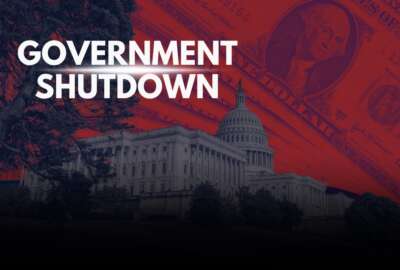Q&A: Phased Retirement
The Office of Personnel Management's final rule on phased retirement is out, and so is additional guidance for agencies. But questions still abound. Federal News...
(This story was last updated Sept. 19, 2014 at 10:30 a.m.)
More than two years after President Barack Obama signed the provision into law, the Office of Personnel Management released the final rule on phased retirement.
Tammy Flanagan, senior benefits director with the National Institute of Transition Planning, joined Senior Correspondent Mike Causey on “Your Turn” to discuss phased retirement. Listen to the full show below.
Following the show, Federal News Radio hosted an online chat to answer listeners’ and readers’ questions on phased retirement. You can view the archived chat here.
We received so many great questions during the chat, but we couldn’t answer them all in the time allowed. We’ve now gone back to our experts for answers to those remaining questions. Find those answers below, as well as answers to questions we received via email, and information copied directly from OPM’s guidance to agencies. You can find the full guidance here.
Jump to topics: Eligibility | Work Schedules | Pay and Benefits | Implementation | Employee Rights | Training and Mentoring
ELIGIBILITY
Can phased retirement apply to any federal employee?
No. Only individuals covered under the Civil Service Retirement System (CSRS) and the Federal Employees Retirement System (FERS) are eligible for participation in phased retirement, consistent with the provisions of the implementing statute and regulations.
Employees who qualify for retirement under the retirement provisions for law enforcement officers, firefighters, nuclear materials couriers, air traffic controllers, members of the Capitol Police, members of the Supreme Court Police, and customs and border protection officers (except for certain employees hired as customs and border protection officers prior to July 6, 2008) are excluded from participation in phased retirement.
Also, federal employees who qualify for retirement under non-CSRS or non-FERS retirement systems (e.g., the Foreign Service retirement system) are ineligible for participation in phased retirement under these provisions.
Are all grade levels eligible for phased retirement?
All grades are eligible for phased retirement, as long as they meet the age and length of service eligibility requirements. For CSRS employees, this is age 55 and 30 years of federal service, or age 60 and 20 years of service. For FERS employees, this is minimum retire age and 30 years of service, or age 60 and 20 years of service.
Can a person who has already retired take advantage of phased retirement?
No, the phased retirement program is only for eligible current employees.
How is “years of service” defined? Entirely in the civil service, or a combination of military and civil service?
Years of service includes a combination of time spent in military and civil service.
For military retirees who receive a military pension and are now GS employees, they would have to pay the military service credit deposit if they were going to use military service towards becoming eligible for phased retirement. This means committing to waiving the military retirement when retiring, and then the 20 years of service would be creditable towards retirement.
Does un-bought back military time count toward the 20-year requirement for phased retirement in the case of a military retiree who is now FERS?
The military deposit would need to be paid prior to entering phased retirement. If a phased annuitant is called to active duty while working in phased retirement, then the person could pay for this service in the same way as other employees. Additionally, employees who owe civilian deposits will need to make a decision regarding payment prior to entering phased retirement.
Are individuals with administratively determined (AD) appointments who have worked years as federal employees allowed to take advantage of the phased retirement program?
Individuals with AD appointments must meet all of the above requirements for phased retirement. If they meet the criteria, it will be up to the agency to approve requests for phased retirement.
Are employees entitled to participate in phased retirement?
No, participation in phased retirement is not an employee entitlement. Participation is voluntary and requires the consent of the employee and the employing agency. An employee must receive written approval from his or her employing agency to participate in phased retirement. OPM says agencies’ decisions to approve or deny a request should be based on a sound business case and uphold merit system principles.
If there are more individuals willing to elect phased retirement than the agency/organization is willing to grant, on what basis does the agency determine which employee(s) get to participate in phased retirement?
The agency has the discretion to determine the criteria used to approve requests to enter phased retirement. The agency should create criteria that allow for a fair and equitable determination of who will be approved to participate in phased retirement. The criteria used to determine which employee(s) get to participate in phased retirement may be subject to bargaining for employees represented by a labor organization.
WORK SCHEDULES
What is the minimum and maximum number of hours an employee must work under phased retirement?
The number of hours a phased retiree can work must be equal to one-half the number of hours the phased retiree would have been scheduled to work had he or she remained in a full-time work schedule. So if an employee typically works 80 hours per biweekly pay period, the employee would work 40 hours.
Can an employee work one month on, one month off? Or does it have to be a few days on then a few days off?
A phased retiree’s work schedule is subject to any applicable agency policy or collective bargaining agreement. According to the most recent OPM guidance, phased retirees must work 40 hours within a biweekly pay period. They also must have an established schedule and may not work on an intermittent basis.
Can a phased retiree participate in overtime?
Yes. If an employee works an excess of the mutually agreed upon hours (for example 42 hours per pay period instead of the usual 40), then that employee is eligible to receive overtime pay.
Can an employee telework while in phased retirement?
An employee’s ability to telework will depend on the individual agreement with the agency. OPM does not specify whether or not telework is permissible.
Is there a maximum period of time that an employee may spend as a phased retiree?
No, there is no maximum limitation on the amount of time an employee may spend in phased retirement. However, an agency may limit the time spent in phased retirement by requiring the employee to agree to a time limit as a condition of approval.
In most, cases, phased retirement will lead to full retirement. But what if someone doesn’t like it and wants to return to full-time employment?
There is an option to return to full-time employment, but the agency would need to approve this. The other option would be to transfer to a different full-time position at the same agency or transfer to another job at a different agency.
PAY AND BENEFITS
How much annual leave will phased retirees earn?
Phased retirees will accrue annual leave in the same manner as part-time employees. The amount of leave will be prorated based on hours in a pay status.
Phased retirees making only half of their salary, so how will that affect the bottom line upon full retirement? Will retirement be calculated on the high three years before the phased retirement?
Upon entering full retirement, employees will be entitled to a composite annuity that consists 50 percent of the retirement they had been receiving since entering phased retirement (adjusted by any COLA’s that have occurred) and 50 percent of the retirement payable at the end of the phased retirement period (using a full-time salary for the high-three and adding credit for sick leave and election of survivor benefits in the final computation).
Can phased retirees receive their FERS annuity supplement? How should a potential phased retiree factor in the loss (or delay) of the FERS supplement normally payable until age 62?
FERS-covered phased retirees are not eligible to receive an annuity supplement. Income during phased retirement includes 50 percent of an employee’s salary and 50 percent of the FERS retirement benefit. If you were fully retired, you would have received the full FERS benefit and the supplement.
Does the annuity receive Cost of Living increases?
The COLA will be added to the 50 percent retirement benefit that was received during phased retirement and then the new retirement will be computed and 50 percent of that amount will be added to the original benefit. It is a little complicated because of other issues, like electing survivor benefits, adding sick leave and considering creditable service issues.
How does phased retirement affect the 240 leave max?
Phased retirees are still employees and will need to be aware of the annual maximum leave carry over. When phased retirees fully retire, they will be paid for their unused annual leave in a lump sum payment.
Will the health or life insurance premiums go up?
Health and life insurance premiums will not go up, but the premiums will be deducted from your gross annuity.
Can phased retirees continue to contribute to their TSP accounts?
Phased retirees are still federal employees, which means they can continue making contributions to the TSP. Phased retirees are subject to the normal employee restrictions regarding TSP loans, financial hardship withdrawals and/or age based withdrawals. They must wait until full retirement to elect post- employment withdrawals from the TSP. Employees in phased retirement will not be subject to required minimum distributions or the TSP withdrawal deadline.
How is the survivor benefit deduction handled during the phased retirement portion of an employee’s career?
A survivor election won’t be made until phased retirement ends. If an employee dies while in phased retirement, the benefits would be paid as a death in service. Click here for more details.
IMPLEMENTATION
When will agencies begin to release their own guidance to implement the program?
OPM hasn’t given agencies a deadline for putting the guidance into place, so the timeline can vary a lot across different agencies. Phased retirement is a big change and affects the ability for the agency to “back-fill” a position. It could be months or, in some cases, maybe a year or more before agencies release their guidance.
Right now, agencies are trying to determine the written guidelines, but none are being released yet. Some of the agencies are waiting for the cabinet level departments to come up with a template, and the underlying agency may adapt these guidelines to their individual needs. For example, the Food and Drug Administration may wait for Health and Human Services to come up with their written guidelines before notifying employees of the FDA specific guidance.
How can employees find out the progress agencies are making regarding the implementation of phased retirement?
As agencies meet to discuss their written plans, information will be provided for employees as those plans are ready to be revealed. Watch your agency notification through email and other agency outlets for direct information from your agency.
Also, watch big agencies, such as the Defense Department and Treasury. They tend to lead the way in programs like this.
What are agencies saying about their ability to provide retirement estimates for both phased retirement and ultimate full retirement?
They aren’t saying yet, but agencies most often use the Government Retirement and Benefits program or Economic Systems, Inc. program for retirement estimates.
Why is there no talk as to the shared payroll providers and their timeframes for supporting the technical pay/personnel changes required to their systems?
There is a lot of work to be done to get this new program up and running, and Nov. 6 is not necessarily going to allow enough time to do this. This date is the date when OPM is going to be ready (hopefully) to accept applications, but this is not necessarily going to be the date that agencies are ready to roll.
Why did it take OPM two years to release the final rule?
OPM says it wanted to ensure it addressed all of the comments it received on the draft rule. The rule received a total of 237 comments.
EMPLOYEE RIGHTS
Can an employee appeal an agency’s decision to deny the employee’s application for phased retirement?
An agency’s denial of an employee’s application for phased retirement is not an appealable adverse action under 5 U.S.C. chapter 75. Depending on the agency’s administrative grievance procedures, a denial of an employee’s application for phased retirement may be grievable. Further, for bargaining unit employees, the agency’s collective bargaining agreement may also provide a method for challenging certain management decisions.
How are phased retirees considered for purposes of a Reduction in Force (RIF)?
For purposes of a RIF, phased retirees are treated the same as any other part- time employees. Additional information on RIF is available in 5 CFR part 351.
Are employees currently participating in phased retirement eligible for Voluntary Separation Incentive Payments (VSIP)?
Yes. An employee leaving phased retirement to separate and enter full retirement may be eligible for a VSIP consistent with the agency’s VSIP authority and any eligibility criteria in 5 U.S.C. chapter 35, subchapter II, and 5 CFR part 576.
TRAINING AND MENTORING
May an agency waive the mentoring requirement?
An authorized agency official may waive the mentoring requirement in the event of an emergency or other unusual circumstances (including active duty in the armed forces), when the authorized agency official determines that the event or circumstance would make it impracticable for a phased retiree to fulfill the mentoring requirement.
How does mentoring work when there is a freeze on hiring?
Some agency hiring is going on. In general, mentoring will apply to current employees who may move up the promotion pipeline once phased retirees enter full retirement.
Will agencies offer a class on phased retirement for staff to determine whether it is a good option for them?
Once agencies determine their written guidelines, they likely will provide some workshops for employees.
In the meantime, Tammy Flanagan is preparing a 3-part webinar series with Micah Shilanski, CFP, that will help employees determine if they would make a good candidate for phased retirement, as well as sessions to show how the phased retirement period will be calculated and the full retirement process and calculation. Click here to register now.
Is there someone employees can talk to one-on-one for more specific information about the program?
You can contact your HR Office, but phased retirement is in the early stages, so they may not have all the answers. A financial adviser might be helpful to sort out whether phased retirement is a good option for you financially.
Copyright © 2024 Federal News Network. All rights reserved. This website is not intended for users located within the European Economic Area.





